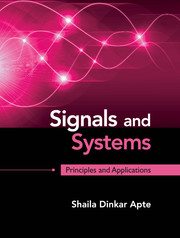Book contents
- Frontmatter
- Dedication
- Contents
- Preface
- 1 Introduction to Signals
- 2 Signals and Operations on Signals
- 3 CT and DT Systems
- 4 Time Domain Response of CT and DT LTI Systems
- 5 Fourier Series Representation of Periodic Signals
- 6 Fourier Transform Representation of Aperiodic Signals
- 7 Laplace Transform
- 8 Z Transform
- 9 Random Signals and Processes
- Index
8 - Z Transform
Published online by Cambridge University Press: 05 May 2016
- Frontmatter
- Dedication
- Contents
- Preface
- 1 Introduction to Signals
- 2 Signals and Operations on Signals
- 3 CT and DT Systems
- 4 Time Domain Response of CT and DT LTI Systems
- 5 Fourier Series Representation of Periodic Signals
- 6 Fourier Transform Representation of Aperiodic Signals
- 7 Laplace Transform
- 8 Z Transform
- 9 Random Signals and Processes
- Index
Summary
Z domain is used for DT signals. The purpose of Z transform for DT signals is similar to that of Laplace transform for analog signals. The Z transform (ZT) is used to characterize a DT system by analyzing its transfer function in the Z domain. The locations of poles and zeros of the transfer function are further used for stability analysis of the DT systems. We will first discuss the significance of a transform. To understand that Laplace transform and Z transform are parallel techniques, we will start with Laplace transform and develop its relation to Z transform. The properties of Z transform will be discussed along with the region of convergence (ROC). The overall strategy of these two transforms is as follows. Find the impulse response from the transfer function. Find poles and zeros of the transfer function and apply sinusoids and exponentials as inputs to find the response. The basic difference between the two transforms is that the s-plane used by S domain is arranged in a rectangular co-ordinate system, while the z-plane used by Z domain uses a polar format. The Z transform provides mathematical framework for designing digital filters based on the well-known theory of analog filters using a mapping technique. The reader will study this part in the course on “Digital signal processing”.
Physical Significance of a Transform
When any natural signal is to be processed, the signal parameters or features are required to be extracted. A transform helps in three ways.
The spectral properties of the signal are better revealed in a transform domain.
The system transfer function directly indicates the locations of poles and zeros that help in analyzing the stability of the system.
A signal, while transmission over a communication channel, needs to be compressed. Energy compaction can be achieved in a transform domain. The signal containing, for example, 128 sample points when transformed in Fourier domain will result in Fourier coefficients 128 in number. However, only a small number of them will have significant values and the others will be tending to zero.
- Type
- Chapter
- Information
- Signals and SystemsPrinciples and Applications, pp. 618 - 692Publisher: Cambridge University PressPrint publication year: 2016



